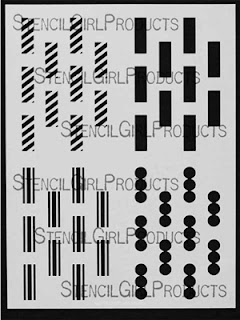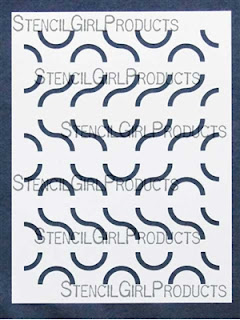Here's my first example: one summer day a few years ago, I was looking at the lawn chair with webbing and decided to come up with a design that would allow the artists to create their own weavings or patterns.
By looking at the pattern carefully, I created different linear patterns that would give multiple variations of the weaving.
The set of four designs above gives a lot of design possibilities. After I digitally created these designs from scratch, I was able to digitally stencil many different patterns - a few of which are shown below:
Shown below is one more sample stenciled with acrylic paints - it was stenciled first with black paint on top of a white box & later layered with paints in various colors:
Another example (a second one) of my creative process involves using my childhood memories of playing games. One of my favorite games involves creating amoeba-like shapes based on the hidden cards in hand and plastic squares with raised quarter circles. Since I saw how different shapes can be created with one basic shape - an arc (quarter circle), I came up with the concept of using three different shapes: quarter rounds, half rounds, and squiggly lines (two quarter rounds combined).
Using these three basic shaped generated on my computer, I have created rows of different arrangements so that different patterns or shapes can be created:
From this one sheet alone, one can create an infinite array of different patterns. It also enabled me to create two other spinoffs (L021 and L022):
From one of the above two stencils, I've created a pattern on the corrugated cardboard for use as a frame:
One third and final example from my stencil design creation process is X & O. It was originally created from two sets made with thick glue gun lines. I was using it as a printing plate rather than as a stencil - hence the darkness of the glue. Before it was used, it was clear.
I did use it as a stencil one time for spraypainting:
But for the purpose of make prints for stencil creation process, I made several more prints with black paint and took photos:
I then uploaded the photos and digitally combine the best ones together to create one stencil.
Although it does not create new patterns, but it does create more interesting visual effects when layered over top of other stencil designs that I've created. Here is one example where I layered the X & O stencil over the chevron stencil on top of gessoed corrugated cardboard.
I used the large stenciled cardboard for making two frames as shown below:
As you have seen, I used various techniques for creating new stencil designs: digitalized observations from ordinary objects, inspirations from puzzles or game boards, and glue gun. I hope I have either inspired you to create your own using my techniques or to create new patterns from my stencils.
You can purchase the above stencils from StencilGirl Products' website here.
*Full disclosure: Andrew Borloz does receive compensation in the form of royalties for his own
stencil designs from Stencil Girl Products used in this project,
however, he does not receive any form of compensation or "free" product used in these art work above
from other designers, manufacturers or retailers.



















































